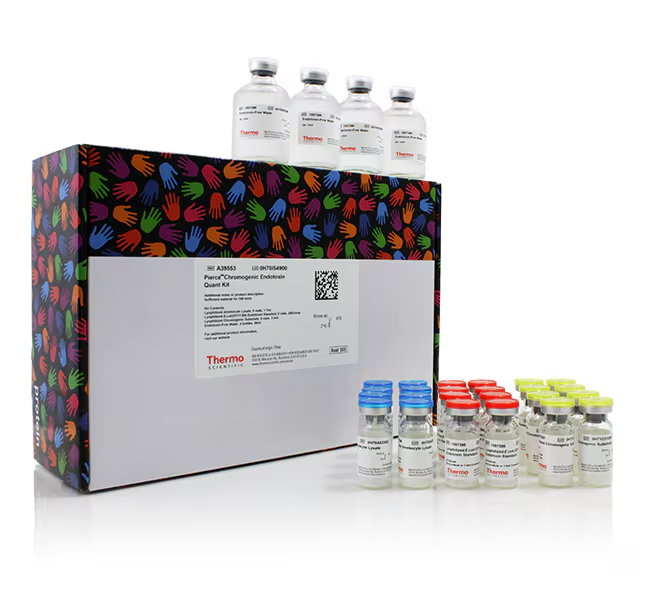
Endotoxin is a lipopolysaccharide (LPS) that constitutes much of the outer membrane of the cell wall in gram-negative bacteria. LPS is the most abundant antigen on the cell surface of most gram-negative bacteria. The Thermo Scientific Pierce Chromogenic Endotoxin Quant Kit is a highly sensitive endpoint assay that accurately measures and detects endotoxin in a protein, peptide, nucleic acid (DNA or RNA), vaccine, or antibody sample using the amebocyte lysate assay. Limulus amebocyte lysate (LAL) is widely used as a simple and sensitive assay for detection of endotoxins.
Features and benefits of the Pierce Chromogenic Endotoxin Quant Kit include:
• Highly sensitive with a broad range—detect as little as 0.01 EU/mL to 1 EU/mL
• Specific—no interference from ß-glucans and suitable for wide range of samples, including plasma, protein, vaccine, plasmid, or nucleic acids (DNA and RNA)
• Fast—perform assay in as little as 20 minutes
Thermo Scientific Pierce Chromogenic Endotoxin Quant Kit is a highly sensitive endpoint assay that uses Limulus amebocyte lysates (LAL) derived from the blood of the horseshoe crab (Limulus polyphemus) to accurately measure and detect endotoxins. Endotoxins can be found in a plasma, protein, peptide, nucleic acid, or antibody sample. These Chromogenic Endotoxin Quant Kits enable detection within broad sensitivity ranges of 0.01 to 1.0 EU/mL* using a standard spectrophotometer or plate reader at 405–410 nm. Our flexible kits allow you to analyze samples in a low range of 0.01–0.1 EU/mL or in a high range of 0.1–1.0 EU/mL, depending on your research needs.
The Pierce Chromogenic Endotoxin Quant Kit uses the amebocyte lysate method, which measures interaction of the endotoxin with the proenzyme Factor C found in circulating amebocytes of the horseshoe crab. The proteolytic activity of this proenzyme is activated in the presence of LPS. Endotoxin levels are determined by measuring the activity of Factor C in the presence of the colorless chromogenic synthetic peptide substrate (Ac-Ile-Glu-Ala-Arg-pNA) that releases p-nitroaniline (pNA) after proteolysis, producing a yellow color that can be measured at an absorbance of 405 nm. The developed color intensity is directly proportional to the amount of endotoxin present in the sample and is calculated using a standard curve of a known amount of endotoxin. This assay has become the industry standard for endotoxin detection in pharmaceuticals, medical devices, food and water testing, as well as life science and medical research.
Association of endotoxin and disease
Endotoxins are released in their surrounding environment when gram-negative bacteria undergo normal cell division or in large concentrations when they are damaged or undergo cell lysis. Given endotoxins are pyrogenic (induce fever) in mammals, identifying and monitoring endotoxin levels is extremely important in many fields, including study of the microbiome to assess peripheral immune response of specific disease. Endotoxins have been associated with non-alcoholic fatty liver disease (NAFLD), meningococcal disease, and various types of sepsis. Endotoxins can be problematic in burn patients due to the translocation of endogenous bacteria and loss of fluids, resulting in GI-related disease such as bowel ischemia or intestinal damage. The severity of symptoms of diseases such as Crohn’s disease, ulcerative colitis, and cystic fibrosis has also been linked to the amount of LPS in the gut.
Specificity of the Pierce Chromogenic Endotoxin Quant Kits
When measured with the Pierce Chromogenic Endotoxin Quant Kit, endotoxin levels in samples are accurately determined using the included endotoxin standard of known concentration that is derived from E.coli strain O111: B4. The low sensitivity range in this assay permits higher dilution of samples that are limited in quantity or contain interfering substances, helping to avoid potential false negatives or false positives in endotoxin quantitation. This assay is also compatible with (1,3)-β-D-glucan, a cell wall component of bacteria and fungi. β-glucans are not pyrogenic, but can activate factor G and trigger the coagulation cascade, producing false positives in the amebocyte lysate assay. β-glucan blockers are not required for this assay and in samples containing ≤10 ng/mL of (1,3)-β-D-glucan, no enhancement is exhibited. Please see Table 1 in data figures for more information on tested reagents and interactions.
Importance of endotoxin testing
Although endotoxins are not infectious organisms, they are toxic and can trigger endotoxic shock, inflammation, or sepsis in animals and tissue culture. Given these compounds are heat-stable and can survive sterilization procedures, identification of endotoxin contamination is extremely important. Sensitive endotoxin testing is also essential in life science and medical research due to the low endotoxin levels required for cell culture and in vivo animal research.
Elimination and testing of endotoxins are also necessary in samples produced from gram-negative bacteria prior to cell transfection or animal injection. Determining endotoxin levels is important to assess the efficiency of endotoxin removal methods and prevent endotoxic shock, inflammation, and/or sepsis in tissue culture cells and animals injected with endotoxin-contaminated proteins.
*One endotoxin unit/mL (EU/mL) equals approximately 0.1ng endotoxin/mL of solution.
Related products:
Pierce™ High Capacity Endotoxin Removal Resin
Pierce™ High Capacity Endotoxin Removal Spin Columns
| Code | Description |
|---|---|
| A39553 | Catalog Number: A39553 |
| A39552S | Catalog Number: A39552S |
| A39552 | Catalog Number: A39552 |

